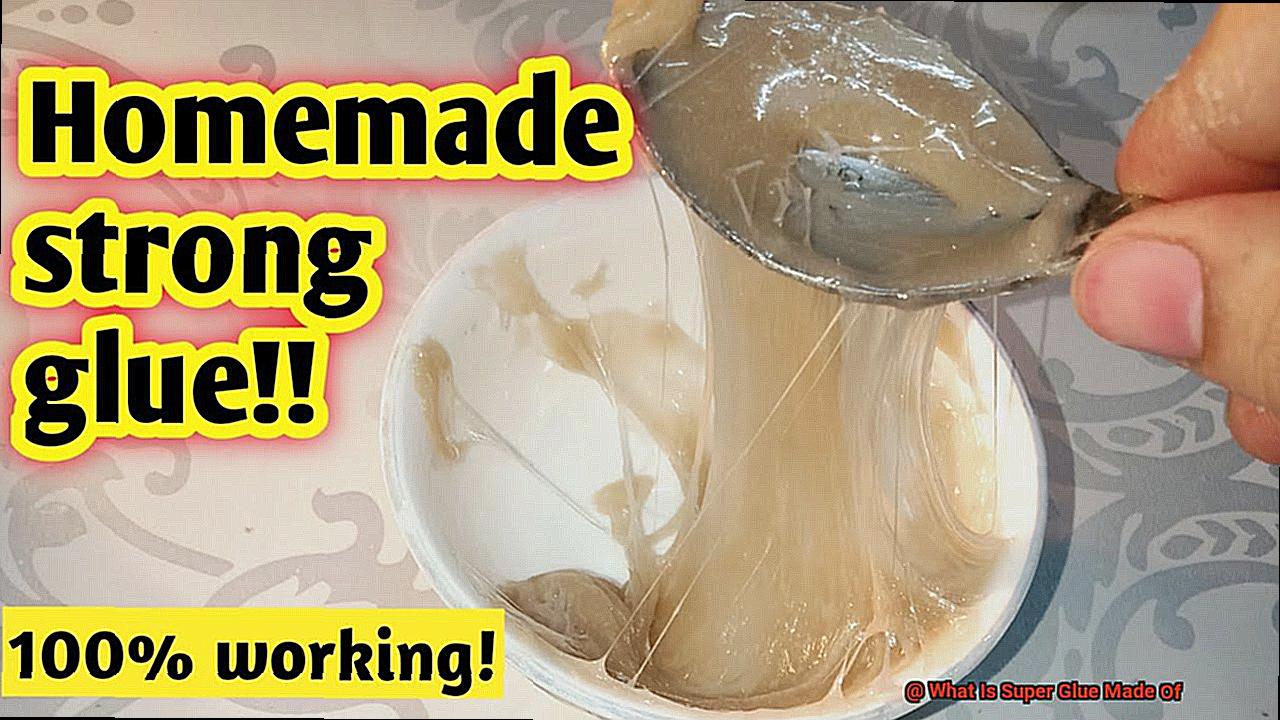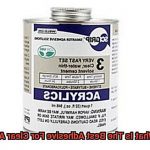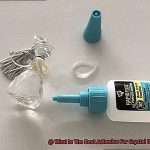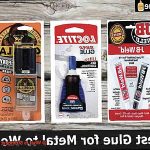Are you a DIY enthusiast or someone who has had to fix something fragile? If so, then you’ve probably turned to Super Glue for help. This powerful adhesive has become a household name, known for its quick-fix abilities that can repair everything from broken ceramics to torn book pages. But have you ever wondered what makes this glue so super?
Believe it or not, the secret lies in its impressive chemistry. Super Glue, also known as cyanoacrylate glue, is made up of an acrylic resin that creates an incredibly strong bond in just seconds. When exposed to moisture – be it from the air, your skin, or even the surfaces you’re trying to bond – the resin undergoes a chemical reaction that results in millions of tiny bonds across the surface area.
But here’s where things get interesting: unlike traditional adhesives that rely on slow solvent evaporation to create a bond, Super Glue uses anionic polymerization to solidify the bond quickly. This unique chemical structure allows for incredibly strong bonds in mere seconds.
So, next time you reach for that trusty tube of Super Glue, remember that you’re not just holding any old adhesive – you’re wielding some seriously impressive chemistry.
What is Super Glue?
Contents
Super glue, also known as cyanoacrylate adhesive, is a revolutionary invention that has transformed the world of adhesives. This fast-acting adhesive is made up of a combination of chemicals that work in perfect harmony to create a powerful bond between surfaces.
At the heart of Super Glue is cyanoacrylate, a monomer that polymerizes rapidly when it comes into contact with moisture. This means that when applied to a surface, the glue hardens quickly, forming a strong and durable bond.
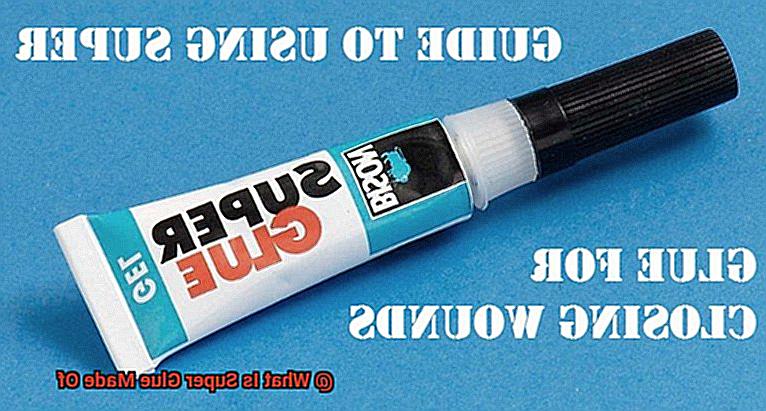
To prevent the cyanoacrylate from breaking down before it polymerizes, an acidic stabilizer is added to the mix. The stabilizer also neutralizes any alkaline substances present on the surface being bonded, ensuring that the bond is strong and long-lasting.
Super glue can be used on a variety of surfaces such as metal, plastic, wood, and ceramics. Some Super Glues may contain fillers such as rubber or silica, which improve adhesion to certain surfaces and add strength.
Super glue comes in various forms including liquid, gel, and spray. Liquid super glue is best for smooth surfaces and small gaps. Gel super glue is ideal for vertical surfaces and porous materials while spray super glue is suitable for large surfaces and hard-to-reach areas.
The discovery of cyanoacrylate dates back to 1942 when Dr. Harry Coover tried to create a clear plastic for gun sights during World War II. However, he soon realized that the compound had strong adhesive properties and was not suitable for his intended use. Several years later, the Eastman Kodak Company developed cyanoacrylate into a commercial adhesive and marketed it as “Super Glue” in the late 1950s.
Today, Super Glue is widely available in hardware stores and online retailers. It has become an essential tool for DIYers and professionals alike due to its versatility and ease of use.
The Main Ingredient of Super Glue
Look no further than super glue. This game-changing adhesive has become a go-to for a variety of applications, from household repairs to industrial manufacturing, all thanks to the power of its main ingredient – cyanoacrylate.
Derived from a compound called ethyl cyanoacetate, cyanoacrylate is a colorless liquid that chemically bonds together during a process known as polymerization. The result? Long chains that form an incredibly strong and durable adhesive. It’s no wonder that super glue is known for its lightning-fast bonding abilities.
But cyanoacrylate’s versatility is what makes it so impressive. It can bond to an incredibly wide range of surfaces, including plastics, metals, ceramics, and even human skin. This makes it an ideal adhesive for various applications. However, it’s important to note that while cyanoacrylate is incredibly strong, it may not be suitable for all materials and surfaces.
While cyanoacrylate is the star of the show when it comes to super glue, other additives are often included to improve its performance even further. For example, some super glues feature rubber particles that increase flexibility and impact resistance. Others may contain accelerators that speed up the bonding process or stabilizers that prevent the glue from breaking down over time.
Additional Ingredients in Super Glue
Super glue, also known as cyanoacrylate adhesive, is a popular adhesive that has become a staple in many households. But did you know that beyond its primary ingredient of cyanoacrylate, there are additional ingredients that significantly enhance its performance? Let’s dive deeper into the world of super glue and explore these fascinating ingredients.
The first essential ingredient is the stabilizer. Without it, the cyanoacrylate would quickly break down when exposed to air or moisture, rendering the glue unusable. Hydroquinone is the most commonly used stabilizer in super glue. It reacts with any water present to form a harmless compound that keeps the glue from degrading.
Another critical ingredient in super glue is the thickening agent. This helps the glue stay in place and not run off the surface before bonding. Methyl methacrylate is often used as a thickening agent in super glue, increasing its viscosity and providing greater control over application.

In some instances, an accelerant is added to speed up the bonding process. This can be useful when time is of the essence but can also make the glue more challenging to work with since it bonds almost instantly. Dimethyltoluidine is a common accelerant used in super glue.
Moreover, some super glue products may contain additional chemicals to provide specific properties such as increased flexibility or resistance to impact. The composition of these additional ingredients varies depending on the specific product and its intended use.
It’s essential to understand that while super glue may seem like a simple adhesive, these additional ingredients play a significant role in its performance and suitability for different applications. Therefore, it’s crucial to read and follow instructions carefully when working with super glue.
How Does Super Glue Work?
Derived from cyanoacrylic acid, cyanoacrylate is a chemical compound that is known for its ability to quickly polymerize or harden when exposed to moisture. When you apply super glue to a surface, the cyanoacrylate molecules start bonding with the surface molecules almost instantly, creating a resilient and long-lasting bond.
The heat generated by this reaction further speeds up the curing process, causing super glue to set very quickly. This rapid-setting property has made super glue a popular choice for construction, woodworking, and DIY projects.
But wait, there’s more. Super glue may also contain stabilizers and thickeners that help improve its performance and consistency. Additionally, some types of super glue may include additional ingredients like rubber or epoxy resins to create specific types of bonds.
However, it’s important to note that super glue may not be ideal for all types of surfaces. It works best on non-porous materials such as metal, plastic, and ceramic. Porous materials like wood or fabric may not bond as well with super glue.
Advantages of Using Super Glue
Super glue might be the solution you need. Also known as cyanoacrylate adhesive, super glue is a popular choice for various industries and households due to its many advantages.
Firstly, one of the main advantages of using super glue is that it dries quickly, usually within seconds. This makes it a game-changer when it comes to bonding small items such as jewelry, plastic, and ceramics. No more waiting around for hours, hoping your project will dry in time.
Secondly, super glue creates a strong bond that can handle high levels of stress and tension. It can bond various materials such as metal, rubber, and wood, making it a versatile adhesive that can be used in a range of applications. You can trust that your project will stay strong even in the most demanding conditions.
Thirdly, super glue is water-resistant, which means it can be used for outdoor applications or in areas with high humidity without losing its bonding strength. This feature makes it perfect for repairing items that are exposed to water or moisture.
Fourthly, super glue is easy to use. It comes in small tubes or bottles with precision applicators that allow for easy and precise application. Plus, it requires no mixing or special tools to use – simply apply and let the magic happen. This feature makes it perfect for those who are not experienced in DIY projects.
Finally, super glue has a long shelf life when stored properly. This means it’s a reliable adhesive to have on hand for future use. You won’t have to worry about it expiring or losing its effectiveness anytime soon.
Disadvantages of Using Super Glue
Super glue, also known as cyanoacrylate adhesive, is a popular solution for bonding materials quickly and effectively. However, it’s important to understand its limitations before diving in. As an expert on the topic, I’m here to share with you some of the disadvantages of using super glue.
Toxicity is one of the main concerns when it comes to super glue. The fumes emitted by the adhesive can irritate your eyes, nose, and throat, causing headaches and dizziness. Prolonged exposure can even lead to more serious respiratory issues like asthma. That’s why it’s crucial to use this adhesive in a well-ventilated area and avoid inhaling the fumes.
Another major drawback of super glue is its brittleness. While it may provide strong and durable bonds, it lacks flexibility and can easily break under stress or pressure. This can be problematic when using it on objects that require some degree of movement or flexibility.
In addition, once opened, super glue has a short shelf life. If not stored properly or used within a certain period, the adhesive can dry out quickly and become useless. Moreover, if you make a mistake during application or need to disassemble the object later on, removing super glue from the surface can be difficult.
Lastly, it’s important to note that super glue is not suitable for use on all materials. Some porous surfaces like wood or fabric may not work well with this adhesive, while certain plastics or foams may even get damaged by it. Always read the label carefully and test the adhesive on a small area before using it on a larger scale.
Different Types of Super Glues
Super glue, also known as cyanoacrylate adhesive, is a versatile and robust adhesive that can bond almost any surface within seconds. However, did you know that there are different types of super glues available in the market? Each type has unique properties and characteristics that make them suitable for specific applications. In this article, we will explore the various types of super glues available and their unique features.
Cyanoacrylate Super Glue
One of the most common types of super glue is cyanoacrylate super glue. It is made from cyanoacrylate esters derived from ethyl cyanoacrylate. This type of glue sets quickly and can bond almost any surface within seconds. It is also water-resistant and durable, making it ideal for various applications such as woodwork, metalwork, and plastic repair.
Epoxy-based Super Glue
Another popular type of super glue is epoxy-based. Epoxy-based super glue is made from epoxy resins and hardeners. This type of glue has a longer setting time than cyanoacrylate super glue but is stronger and more durable. It is also resistant to heat, chemicals, and impact, making it ideal for industrial applications.
Polyurethane-based Super Glue
Polyurethane-based super glue is another popular type of super glue. It is made from polyurethane prepolymers mixed with curing agents. Polyurethane-based super glue has a strong bonding capacity and can fill gaps and cracks in materials. It is also water-resistant and flexible, making it ideal for use in construction and automotive industries.
Rubber-toughened Super Glue
Rubber-toughened super glue contains rubber particles that help increase its flexibility and impact resistance. It is ideal for bonding materials that may experience stress or movement, such as wood or leather.
Gel Super Glue
Gel super glues are thicker and more viscous than regular super glues. They are ideal for vertical applications or bonding porous materials such as paper or cloth.
In addition to these types of super glues, there are also specialized formulas available for specific applications, like high-temperature environments, underwater applications, or bonding medical devices.
How to Choose the Right Super Glue for Your Project?
With so many options available, it can be overwhelming to choose the right one. To simplify the process, consider the following five factors.
Material Compatibility
Different super glues are formulated for different materials. It’s important to choose a glue that is compatible with the materials you will be bonding. For example, if you’re working with metal, choose a super glue specifically designed for metal bonding.
Bond Strength
Consider the level of strength you need for your bond. Some super glues are designed for temporary bonding, while others are formulated for permanent and durable bonds. If your project requires a strong and lasting bond, choose a glue with high bond strength.
Viscosity
The viscosity of the glue can affect how easy it is to apply and how well it fills gaps between materials. A thin, runny glue is ideal for tight spaces, while a thicker, gel-like glue works better for larger gaps.
Drying Time
The drying time of the glue is another important factor to consider. Quick-drying glues are great for projects that require fast results, but they don’t offer much time for repositioning. If you need more time to adjust your materials after applying the glue, choose a slower-drying adhesive.
Special Properties
Finally, consider any special features or properties you may need in your super glue. Do you need a glue that can withstand extreme temperatures or moisture? Are you working with materials that will be subjected to impact or vibration? Look for a glue that has the properties necessary to meet your project’s demands.
1hY1jyGNzIo” >
Conclusion
In conclusion, Super Glue is an exceptional adhesive that has transformed the world of adhesives. Its remarkable chemistry relies on the rapid polymerization of cyanoacrylate when exposed to moisture, creating incredibly strong bonds in mere seconds. The addition of stabilizers, thickeners, accelerants, and other additives further enhances its performance and versatility.
Super Glue can bond various materials such as metal, plastic, wood, and ceramics and comes in different forms like liquid, gel, and spray. Its advantages include quick drying time, high bond strength, water resistance, ease of use, and long shelf life. However, it also has some disadvantages like brittleness and toxicity.
Choosing the right Super Glue for your project requires careful consideration of factors such as material compatibility, bond strength, viscosity, drying time, and special properties like resistance to extreme temperatures or moisture.
Overall Super Glue has become an indispensable tool for DIYers and professionals alike due to its versatility and ease of use. So next time you reach for that trusty tube of Super Glue remember that you’re wielding some seriously impressive chemistry that can fix almost anything.

